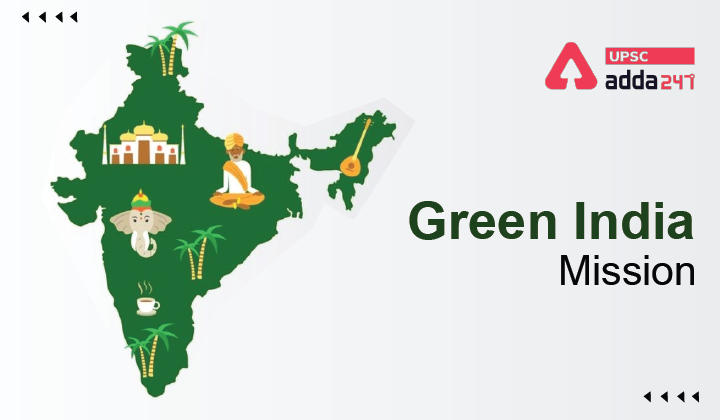Table of Contents
Green India Mission- Relevance for UPSC Exam
- GS Paper 2: Governance, Administration and Challenges- Government policies and interventions for development in various sectors and issues arising out of their design and implementation.
Green India Mission in News
- The Development Monitoring and Evaluation Office (DMEO), NITI Aayog, Government of India, has conducted the Evaluation of the National Mission for a Green India (Green India Mission) in 2020-21.
- Evaluation of the National India Mission was conducted on aspects such as Relevance, Effectiveness, Efficiency, Sustainability, Impacts and Equity within the scheme.
- NITI Aayog has further recommended the continuation of the National Mission for a Green India scheme.
Key Points about National Mission for a Green India
- About: National Mission for a Green India (GIM), also known as Green India Mission, is one of the eight Missions under the National Action Plan on Climate Change (NAPCC).
- Mandate: Green India Mission aims at protecting, restoring, and enhancing India’s forest cover and responding to Climate Change.
- GIM also aims to conserve, restore and enhance the decreasing forest cover of India, with a combination of adaptation and mitigation strategies to react to climate change.
- Target: The target under the Green India Mission is 10 m ha on forest and non-forest lands for increasing the forest/tree cover and improving the quality of the existing forests.
- Implementing Agencies at Various Levels:
- National Level: Ministry of Environment and Forests is entrusted with the implementation of the Green India Mission (GIM).
- State-Level: The State Forest Development Agency guides the mission at the state level.
- District level: At the district level, the implementation is to be done by the Forest Development Agency.
- Local-level: The gram sabha and various committees are the key institutions for planning and implementation at the village level.
- Urban areas: The ward level committees like Residents Welfare Association (RWA) linked to the municipality/municipal corporations will facilitate planning and implementation under the mission.
Green Hydrogen Production in India: Scaling-up Alkaline Electrolyser technology
Key Targets under Green India Mission (GIM)
- Targets: Growth in forest or tree cover to 5 million hectares (mha) and increase the quality of forest cover in another 5 million hectares of forest or non-forest lands. Sub-targets include-
- Increase the quality of degrading moderately dense forests – 1.5 million hectares (ha).
- Ecologically restore open forests which are being degraded – 3 million hectares (ha)
- Grasslands revival – 0.4 million hectares
- Wetlands revival – 0.10 million hectares
- Ecological restoration of shifting cultivation areas, mangroves, scrub, ravines, cold deserts, & abandoned mining areas – 1.8 million hectares with different sub-targets.
- Increase in forest cover in urban areas and its outskirts – 0.20 million hectares.
- Increase in forest and tree cover on marginal agricultural lands/fallows and other non-forest lands which comes under agroforestry – 3 million hectares.
- Increase forest-based livelihood income for about 3 million households in and around these forest areas.
- Increase Carbon Dioxide sequestration to a range of 50 to 60 million tonnes by 2020.
National Action Plan on Climate Change (NAPCC)





 TSPSC Group 1 Question Paper 2024, Downl...
TSPSC Group 1 Question Paper 2024, Downl...
 TSPSC Group 1 Answer key 2024 Out, Downl...
TSPSC Group 1 Answer key 2024 Out, Downl...
 UPSC Prelims 2024 Question Paper, Downlo...
UPSC Prelims 2024 Question Paper, Downlo...
